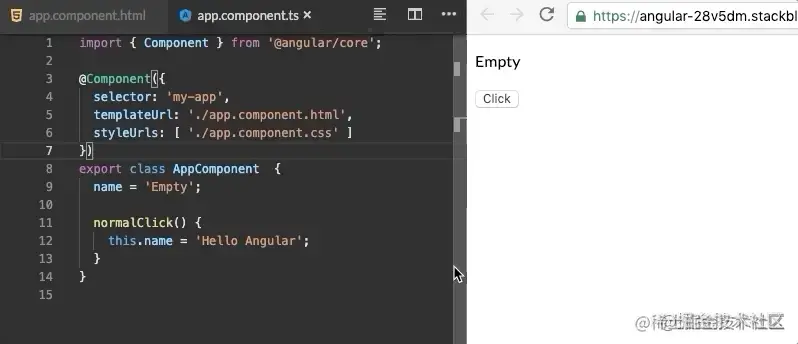淺析Angular變更檢測中的DOM更新機制

前端(vue)入門到精通課程,老師線上輔導:聯絡老師
Apipost = Postman + Swagger + Mock + Jmeter 超好用的API偵錯工具:
變更檢測是中很重要的一部分,也就是模型和檢視之間保持同步。在日常開發過程中,我們無需瞭解變更檢測,因為Angular都幫我們完成了這一部分工作,讓開發人員更加專注於業務實現,提高開發效率和開發體驗。但是如果想要深入使用框架,或者想要寫出高效能的程式碼而不僅僅只是實現了功能,就必須要去了解變更檢測,它可以幫助我們更好的理解框架,偵錯錯誤,提高效能等。【相關教學推薦:《》】
Angular的DOM更新機制
我們先來看一個小例子。

當我們點選按鈕的時候,改變了name屬性,同時DOM自動被更新成新的name值。
那現在有一個問題,如果我改變name的值後,緊接著把DOM中的innerText輸出出來,它會是什麼值呢?
import { Component, ViewChild, ElementRef } from '@angular/core';
@Component({
selector: 'my-app',
templateUrl: './app.component.html',
styleUrls: [ './app.component.css' ]
})
export class AppComponent {
name = 'Empty';
@ViewChild('textContainer') textContainer: ElementRef;
normalClick(): void {
this.name = 'Hello Angular';
console.log(this.textContainer.nativeElement.innerText);
}
}登入後複製你答對了嗎?
那這兩段程式碼中到底發生了什麼呢?
如果我們用原生JS來編寫這段程式碼,那麼點選按鈕後的檢視肯定不會發生任何變化,而在Angular中卻讓檢視發生了變化,那它為什麼會自動把檢視更新了呢?這離不開一個叫做zone.js的庫,簡單來說,它是對發生值改變的事件做了一些處理,這個會在後面的部分詳細講解,這裡暫時知道這個就可以了。
如果我不想讓這個庫做這些處理,Angular還為我們提供了禁用zone.js的方法。
可以在main.ts中設定禁用zone.js。
import { enableProdMode } from '@angular/core';
import { platformBrowserDynamic } from '@angular/platform-browser-dynamic';
import { AppModule } from './app/app.module';
import { environment } from './environments/environment';
if (environment.production) {
enableProdMode();
}
platformBrowserDynamic().bootstrapModule(AppModule, {
ngZone: 'noop'
})
.catch(err => console.error(err));登入後複製
當我們禁用zone.js,檢視並未發生更新。到原始碼裡找一下檢視更新的相關程式碼。
*/
class ApplicationRef {
/** @internal */
constructor(_zone, _injector, _exceptionHandler, _initStatus) {
this._zone = _zone;
this._injector = _injector;
this._exceptionHandler = _exceptionHandler;
this._initStatus = _initStatus;
/** @internal */
this._bootstrapListeners = [];
this._views = [];
this._runningTick = false;
this._stable = true;
this._destroyed = false;
this._destroyListeners = [];
/**
* Get a list of component types registered to this application.
* This list is populated even before the component is created.
*/
this.componentTypes = [];
/**
* Get a list of components registered to this application.
*/
this.components = [];
this._onMicrotaskEmptySubscription = this._zone.onMicrotaskEmpty.subscribe({
next: () => {
this._zone.run(() => {
this.tick();
});
}
});
...
}
/**
* Invoke this method to explicitly process change detection and its side-effects.
*
* In development mode, `tick()` also performs a second change detection cycle to ensure that no
* further changes are detected. If additional changes are picked up during this second cycle,
* bindings in the app have side-effects that cannot be resolved in a single change detection
* pass.
* In this case, Angular throws an error, since an Angular application can only have one change
* detection pass during which all change detection must complete.
*/
tick() {
NG_DEV_MODE && this.warnIfDestroyed();
if (this._runningTick) {
const errorMessage = (typeof ngDevMode === 'undefined' || ngDevMode) ?
'ApplicationRef.tick is called recursively' :
'';
throw new RuntimeError(101 /* RuntimeErrorCode.RECURSIVE_APPLICATION_REF_TICK */, errorMessage);
}
try {
this._runningTick = true;
for (let view of this._views) {
view.detectChanges();
}
if (typeof ngDevMode === 'undefined' || ngDevMode) {
for (let view of this._views) {
view.checkNoChanges();
}
}
}
catch (e) {
// Attention: Don't rethrow as it could cancel subscriptions to Observables!
this._zone.runOutsideAngular(() => this._exceptionHandler.handleError(e));
}
finally {
this._runningTick = false;
}
}
}登入後複製大致解讀一下,這個ApplicationRef是Angular整個應用的範例,在建構函式中,zone(zone庫)的onMicrotaskEmpty(從名字上看是一個清空微任務的一個subject)訂閱了一下。在訂閱裡,呼叫了tick(),那tick裡做了什麼呢?
思考: 上次說了最好訂閱不要放到constructor裡去訂閱,這裡怎麼這麼不規範呢?
當然不是,上次我們說的是Angular元件裡哪些應該放constructor,哪些應該放ngOnInit裡的情況。但這裡,ApplicationRef人家是一個service呀,只能將初始化的程式碼放constructor。
在tick函數裡,如果發現這個tick函數正在執行,則會丟擲異常,因為這個是整個應用的範例,不能遞迴呼叫。然後,遍歷了所有個views,然後每個view都執行了detectChanges(),也就是執行了下變更檢測,什麼是變更檢測,會在後面詳細講解。緊接著,如果是devMode,再次遍歷所有的views,每個view執行了checkNoChanges(),檢查一下有沒有變化,有變化則會拋錯(後面會詳細說這個問題,暫時跳過)。
那好了,現在也知道怎麼能讓它更新了,就是要呼叫一下ApplicationRef的tick方法。
import { Component, ViewChild, ElementRef, ApplicationRef } from '@angular/core';
@Component({
selector: 'app-root',
templateUrl: './app.component.html',
styleUrls: ['./app.component.scss']
})
export class AppComponent {
name = 'Empty';
@ViewChild('textContainer') textContainer: ElementRef = {} as any;
constructor(private app: ApplicationRef){}
normalClick(): void {
this.name = 'Hello Angular';
console.log(this.textContainer.nativeElement.innerText);
this.app.tick();
}
}登入後複製果然,可以正常的更新檢視了。
我們來簡單梳理一下,DOM的更新依賴於tick() 的觸發,zone.js幫助開發者無需手動觸發這個操作。好了,現在可以把zone.js啟用了。
那什麼是變更檢測呢?繼續期待下一篇哦。
更多程式設計相關知識,請存取:!!
以上就是淺析Angular變更檢測中的DOM更新機制的詳細內容,更多請關注TW511.COM其它相關文章!